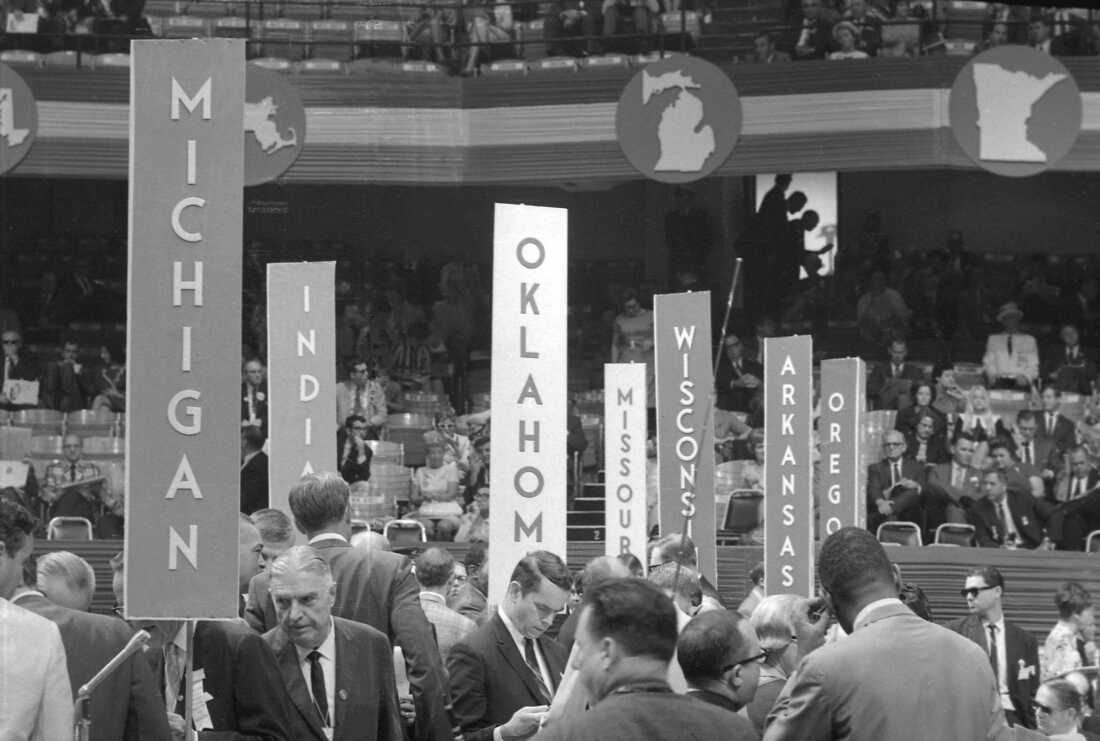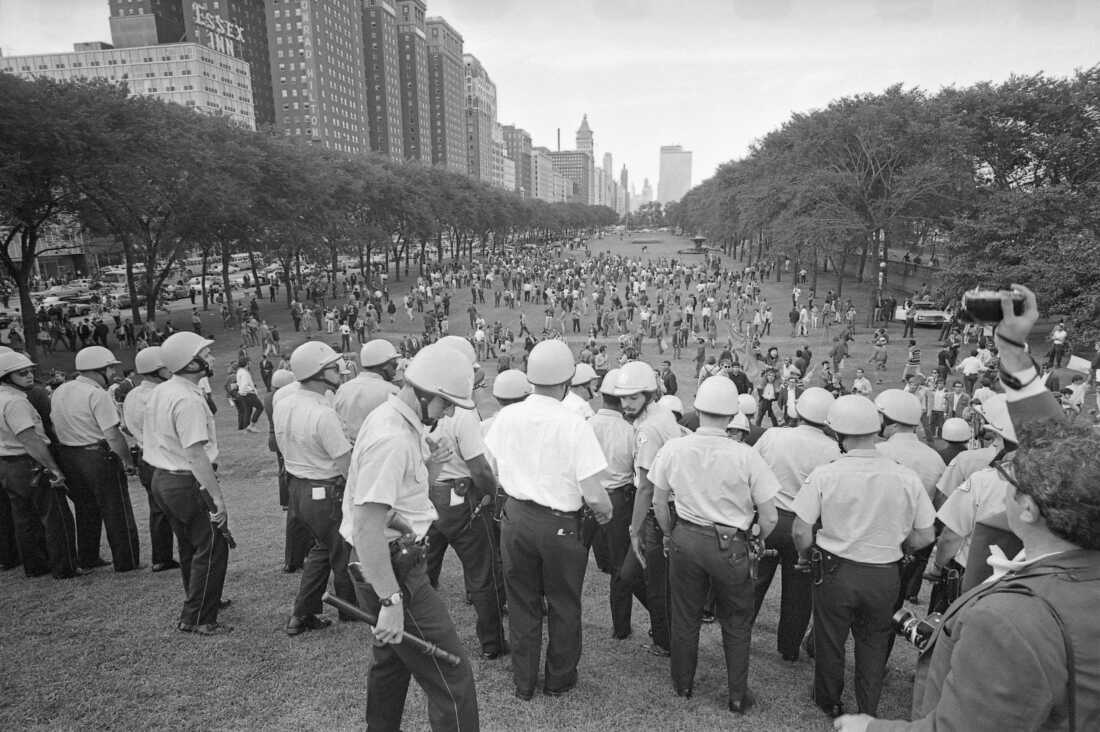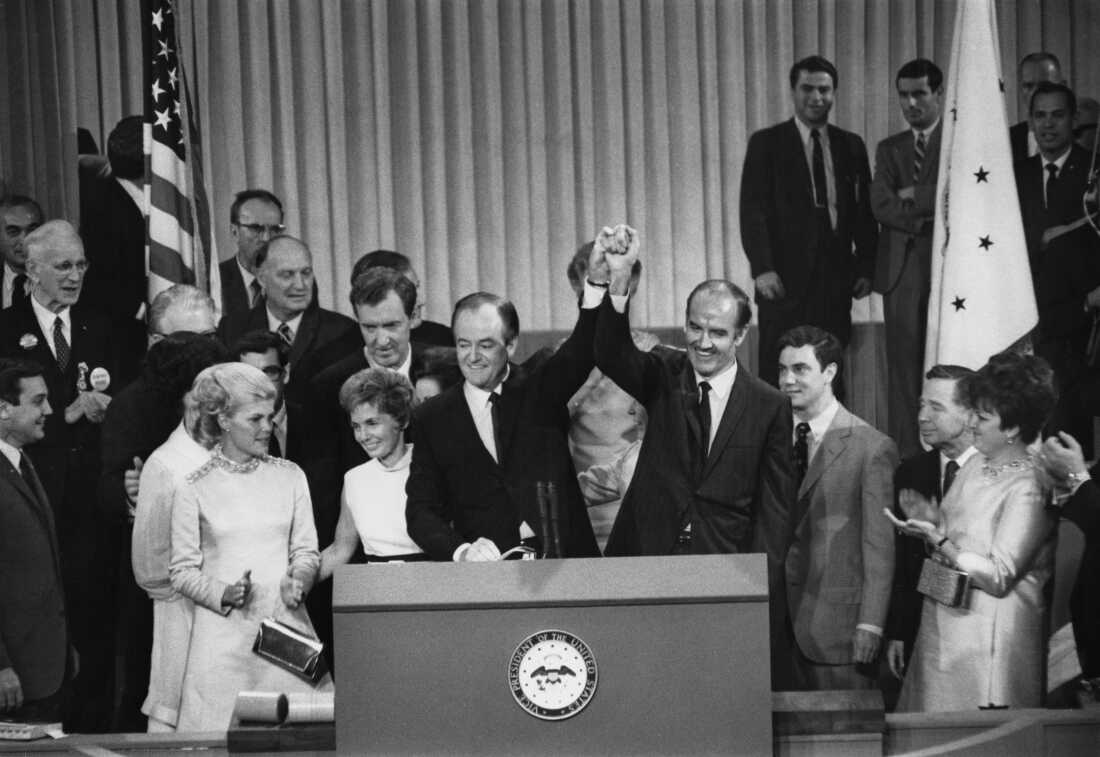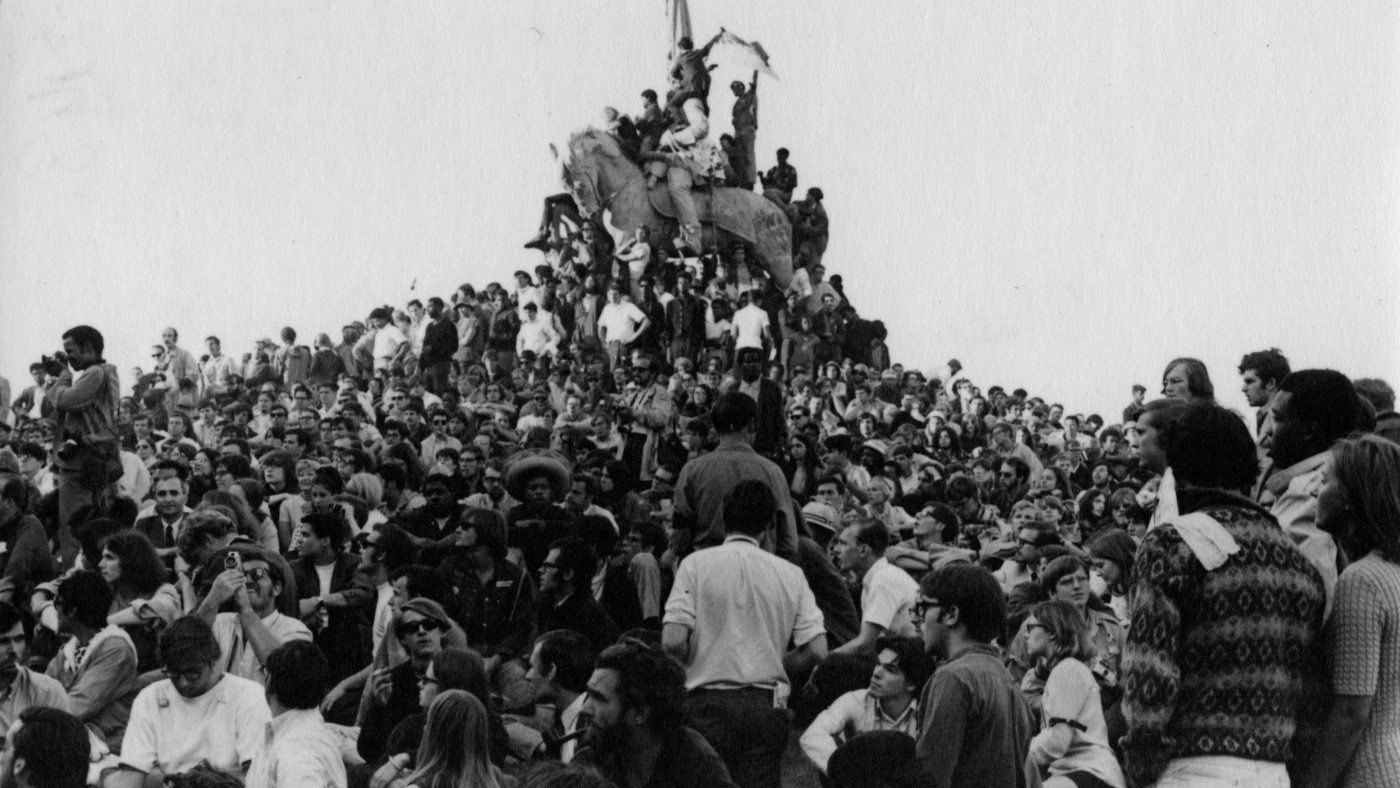Students crowded around General Logan Monument during the 1968 National Democratic National Convention in Chicago, August 1968.
Peter Bullock/Chicago History Museum/Getty Images
hide caption
toggle caption
Peter Bullock/Chicago History Museum/Getty Images
For some Americans, just saying “Chicago 68” is enough to bring it all back. Add the words, “Democratic National Convention” and millions more can visualize brawling delegates, billowing clouds of tear gas and police batons flailing at long-haired protestors.
The chant went up from witnesses of the street battle at the time: “The whole world is watching! The whole world is watching!”
Much of it was. And the memory has been a kind of curse on the Democratic Party and on the Windy City itself. Prior to 1968, Chicago had easily hosted the most presidential nominating conventions of any city. There had been nine Democratic conventions in the centrally located and convention-friendly city and — 14 Republican ones.
But neither party returned after that until 1996, when the Democrats ventured back using a convention facility far from the downtown scenes reminiscent of 1968. This month’s return will be their first since then; and the Republicans have not been back at all.

General view of the delegates from different states sit and stand during the 1968 Democratic National Convention, held at the International Amphitheatre in Chicago, Aug. 28, 1968.
Donaldson Collection/Getty Images
hide caption
toggle caption
Donaldson Collection/Getty Images
National political conventions are by nature difficult-to-manage events. Even when the presidential nomination is not in question like it was in 1968, there can be conflicts and controversies that thousands of news people are standing by to amplify. But there has not been a convention to compare to Chicago ‘68.
In the months leading up to DNC 2024, Chicago ‘68 has been repeatedly conjured as the epitome of disaster like the sinking of the Titanic, or the stock market crash of ‘29. Organizers of various protests planned for this year have invoked the memory in promoting their own current plans. But if some saw dark clouds gathering over the Windy City again this August, the forecast may have brightened in recent weeks. Attempts will surely be made to protest the Biden administration’s support for Israel or its struggle to deal with immigration. But there is nothing in the current political climate to compare to that of 1968 and its all-encompassing anxiety over Vietnam.

As they stand in front of the CBS News booth, protesters hold up ‘Stop the War’ signs on the floor of the Democratic National Convention in the International Amphitheatre, Chicago, Aug. 28, 1968.
CBS Photo Archive/Getty Images
hide caption
toggle caption
CBS Photo Archive/Getty Images
What happened during the 1968 Democratic National Convention?
Recalling that hot week still requires a vocabulary of violence with talk of a fight, a battle and, most of all, a war.
Let’s start with the fight. It involved what happened inside the convention hall.
On the first night, there was contention over which delegations should be seated from Texas and other states.
The second night was consumed by struggles over the party platform language.
And the rest of the week was spent feuding over who would speak, who would preside over the official session and, of course, who would be the nominee. By the third and fourth nights these fights included incidents of pushing and shoving. Punches were thrown.
Much of the fight inside the International Amphitheater was a reaction to what was going on outside.

People survey the damage done to Grant Park after riots broke out during a protest of the 1968 Democratic National Convention, Chicago, Aug. 28, 1968.
Santi Visalli/Getty Images
hide caption
toggle caption
Santi Visalli/Getty Images
On the convention’s third night, thousands of anti-war protesters, mostly young and featuring many students and people of color, broke out of their assigned areas near the convention hall and marched to the stately Conrad Hilton Hotel where the convention had its headquarters. There, on the downtown’s iconic Michigan Avenue, they were set upon by Chicago police wielding nightsticks and pepper spray. This would later be described as a “police riot” in the report of an official investigation chaired by the governor of Illinois.
It became known as the “Battle of Michigan Avenue.” But like the floor fights, the battle was really about the war. The war was in Vietnam and adjacent parts of Southeast Asia — but in 1968 it was coming home. And it made Chicago ‘68 what it was.
Other issues and animosities contributed, to be sure, not least the bellicose attitude of the city’s dictatorial mayor Richard J. Daley. Having fought to have the convention in Chicago, Daley was intent on making it a showcase for his city and himself. And he was incensed by the throngs of anti-war protesters threatening to spoil it all. He ordered his police force to work 12-hour shifts and pushed for thousands of fully armed National Guardsmen and U.S. Army units to back them up.

Police and demonstrators are in a melee near the Conrad Hilton Hotel on Chicago’s Michigan Avenue August 28, 1968, during the Democratic National Convention.
Bettmann/Getty Images
hide caption
toggle caption
Bettmann/Getty Images
The war had transformed the political landscape well before the ‘68 DNC
In effect, the war had already knocked out the Democratic incumbent president, Lyndon B. Johnson, universally known as LBJ. To the shock of official Washington, the party and the nation, LBJ had ended his reelection campaign nearly five months before the convention.
After assuming office on the assassination of John F. Kennedy in 1963, LBJ had built a record of landmark legislation, including the Civil Rights Act, the Voting Rights Act, Medicare and Medicaid, immigration reform and a host of other programs known collectively as the “Great Society.” He had won a term as president in his own right with more than 60% of the popular vote in 1964, carrying 44 states.
But all that had been overshadowed by the war. Beginning in 1964, LBJ had repeatedly escalated the U.S. military commitment to an unpopular government in South Vietnam. That government was fighting a war against Communist insurgents and regular troops from North Vietnam supported by Russia and China.
It had been a relatively remote conflict when LBJ took office, but he greatly expanded the troop numbers and doubled the monthly quotas for the U.S. Army draft. By 1968, more than half a million Americans were serving in Vietnam, and U.S. warplanes were relentlessly bombing targets on both sides of the “demilitarized zone.”

Chicago, IL- Vice-President Hubert H. Humphrey (l) and Senator Eugene McCarthy confront each other at a meeting with the California delegation to the Democratic National Convention here August 27, 1968.
Bettmann/Getty Images
hide caption
toggle caption
Bettmann/Getty Images
Early that year, news of the Communists’ initial success in its “Tet Offensive” made the war seem futile. Respected journalists such as CBS legend Walter Cronkite went to the front and called the war a quagmire. LBJ’s approval in the polls briefly fell below 40% in 1967 for the first time. Campus protests grew in size and media attention. For much of the country, war was becoming the overriding issue.
LBJ managed to win the New Hampshire primary but a little-known, anti-war senator from Minnesota named Eugene McCarthy got 42% of the vote there. Within days, a far better-known senator – Robert F. Kennedy from New York, brother of JFK – also decided to challenge the incumbent.
Kennedy blew past the rather professorial McCarthy, galvanizing the party’s traditional power centers, including labor unions and racial minorities. Kennedy’s youthful charisma stirred memories of his martyred brother and renewed the hopeful promise of his brief presidency.
The rise of the anti-war candidates certainly weighed on LBJ, but the decision to end the campaign had been a subject of debate within LBJ’s family and inner circle for months. LBJ was ambivalent about another term, and his biographers have attributed his withdrawal at least in part to heart disease and other issues of health – including sheer exhaustion.

Chicago’s Mayor Richard J. Daley makes the welcoming address August 26, 1968, to delegates and guests at the 1968 Democratic National Convention, as a large part of the Illinois delegation demonstrates enthusiastically for him in the foreground.
Bettmann/Getty Images
hide caption
toggle caption
Bettmann/Getty Images
Across the country there was a rising resistance to the war
Whatever his mix of motivations, LBJ made an Oval Office address to the nation on March 31. He said he would not seek or accept the nomination for another term, pledging instead to devote all his energies to finding a way out of Vietnam. Stunning as it was, the decision played well. LBJ was hailed as a statesman and his approval polls briefly went back above 50%.
But the chaos of that spring continued. Four days after LBJ withdrew, Martin Luther King Jr. was assassinated in Memphis. Rioting followed in more than 100 cities around the country, including the nation’s capital, with the level of violence rising and falling through April and May.
In the first week of June, the primaries ended with Kennedy winning California’s prize cache of delegates. “Now it’s on to Chicago and win there!” Kennedy told his cheering supporters in Los Angeles that night.
But minutes later he was shot. He died the next day. The proximity to King’s slaying and the flashbacks to his brother raised the emotional intensity still higher.

An anti-Vietnam War protestor confronts two National Guardsmen as a reporter records the exchange outside the 1968 Democratic National Convention, Chicago, August 1968.
Santi Visalli/Getty Images
hide caption
toggle caption
Santi Visalli/Getty Images
And through it all, the question of who would be the incumbent party’s standard bearer remained unresolved.
Kennedy and McCarthy had won a significant number of delegates between them, and other candidates joined the fray before Chicago. But none had nearly enough delegates to be nominated, and in 1968 most delegates to the convention were still chosen by caucuses dominated by state party chairs and other officials loyal to the party establishment.
That meant the votes for nomination could be delivered to LBJ’s favored successor, Vice President Hubert H. Humphrey. Under the party rules as they stood at the time, Humphrey could be nominated without winning any delegates in that year’s primaries at all. Indeed, he did not enter any.
Although he had been a champion of civil rights and other progressive causes, Humphrey’s loyalty to LBJ disqualified him in the eyes of many Democrats. His refusal to denounce the war — or fight for a better “peace plank” in the platform — damned him for the anti-war activists. Yet delegates elected to vote for anti-war candidates were powerless to stop Humphrey’s ascent.

General view of police lined up and holding batons in Grant Park trying to control the crowd with protesters during the 1968 Democratic National Convention in Chicago, Illinois, August 1968.
Donaldson Collection/Getty Images
hide caption
toggle caption
Donaldson Collection/Getty Images
So, for millions, grief and frustration turned to anger, and all this was coming together just before the convention in Chicago, where it would feed into the greater grief and anger about the war. Storm clouds were gathering over Chicago in the days before the convention. Even as the delegates began arriving, parks and public spaces were filling with thousands of angry protesters who had already begun demonstrating days before the convention began.
A closer look at who was protesting and the “Chicago 8”
The anti-war movement up to that time had many components and sources. It had been associated with college campuses, to be sure, but also with churches and other religious organizations and other institutions. It included the radical Students for a Democratic Society but also nonviolent veterans of the civil rights movement and other activists.
In 1966 a protest organization arose calling itself the Mobilization Committee Against the War and focusing on the upcoming convention. Soon known simply as the MOBE, the group reached out in many directions, “calling in the tribes” for a show of unity and force in Chicago.
Although it was the central organizing entity, the MOBE was often upstaged in the media by a far smaller but more aggressive and media-savvy group called the “Young Independent Party” – or “yippies” for short. Their leaders such as Abbie Hoffman and Jerry Rubin soon became the face of the peace movement for many Americans

American political activists and anti-war demonstrators known as the Chicago Seven speak to reporters at a press conference after being charged with contempt of court during their trial for conspiracy to incite violence at the 1968 Democratic National Convention, Chicago, Oct. 8, 1969. Standing left to right, Abbie Hoffman, John Froines, Lee Weiner, David Dellinger, Rennie Davis, and Tom Hayden; seated, center, Jerry Rubin; beside him is Nancy Kurshan.
David Fenton/Archive Photos/Getty Images
hide caption
toggle caption
David Fenton/Archive Photos/Getty Images
The variety of personalities involved in the protests was later highlighted by the prosecution of the so-called “Chicago Eight,” including Hoffman and Rubin, who were indicted by a federal grand jury in 1969 for conspiracy and crossing state lines to incite a riot during the convention.
One of the original eight was Bobby Seale, an early organizer of the Black Panther Party, who had been in Chicago for the convention. In the courtroom, Seale was not allowed the lawyer he wanted and clashed with the judge, Julius Hoffman (no relation to Abbie). The judge ordered Seale bound, gagged and chained to a chair, providing yet another dramatic note to the unusual proceedings.
Seale’s case was later separated from the others. And while all defendants were eventually cleared of the original charges, Seale and others were sent to prison for months by Judge Hoffman for contempt of court.
The trial itself has been the subject of several movies, including one in 2020 that revived interest in the Chicago events of 1968 for a new generation of Netflix users.
Consequences, immediate and lasting – including today’s primary and caucus system
Chicago ’68 continued to resonate in that year’s election, and to some degree in all that followed. In the immediate crisis of the election, the Democratic Party establishment and most of its elected officeholders rallied around Humphrey, who worked hard to reunite the party.
At the end of August, some polls showed Humphrey trailing the GOP nominee Richard Nixon by as much as 16 percentage points. But as Humphrey opened some distance from LBJ on the war and LBJ himself pushed a peace deal on Vietnam, the polling gap shrank dramatically.

American politician Hubert Humphrey and defeated nominee, American politician George McGovern after Humphrey had been nominated as the 1968 presidential election on the final day of the 1968 Democratic National Convention, held at the International Amphitheatre in Chicago, Aug. 29, 1968.
Pictorial Parade/Archive Photos/Getty Images
hide caption
toggle caption
Pictorial Parade/Archive Photos/Getty Images
By November the race was widely regarded as a toss-up. Nixon wound up winning the popular vote by only about 500,000 nationwide — or just seven-tenths of 1% of the total. But it was not as close in the Electoral College, where Nixon got 301 of the 538 votes cast.
Could a peace breakthrough have made the difference in the 11th hour? Some historians believe it might have happened but for the interference of emissaries from Nixon who promised the South Vietnamese regime a better deal under a new, Republican president.
But the fallout from Chicago ’68 was just beginning. The frustration of the peace delegates fueled a movement to revise the party’s nominating system, especially the process for choosing delegates who would vote at the convention. One anti-war senator, George McGovern of South Dakota, led a commission appointed by the national party to study and recommend changes to the delegate selection system.
Those changes began to be used in 1972 and became the primary and caucus process that was eventually adopted by both major parties. While this was regarded as a triumph by the anti-war factions of the party, it was not welcomed by all.
McGovern went from reformer to reform’s beneficiary when he won the Democratic nomination for president in 1972. But his resounding defeat that November, when he carried but one state, raised immediate questions about the new system. It was surely more democratic, putting the party’s ultimate decision in the hands of far more people, including all who took part in primaries and caucuses. But did it produce as many winners as the old system?
If the ultimate test of a party is electoral success, the Democrats had more success when their nominating process was less democratic. In the 10 presidential election cycles ended in 1968, Democratic nominees had won seven times.
In the next 10 cycles ended in 2008, Democrats would win just four times.

